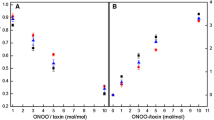Abstract
St I is a toxin present in the Caribbean Sea anemone Stichodactyla helianthus which is highly hemolytic in the nanomolar concentration range. Exposure of the toxin to free radicals produced in the pyrolysis of 2,2′-azobis(2-amidinopropane) hydrochloride leads to a progressive loss of hemolytic activity. This loss of hemolytic activity is accompanied by extensive modification of tryptophan residues. On the average, three tryptophan residues are modified by each inactivated toxin. The loss of hemolytic activity of St I takes place without significant changes in the protein structure, as evidenced by the similarity of the fluorescence and CD spectra of native and modified proteins. Also, the native and modified ensembles present a similar resistance to their denaturation by guanidinium chloride. The hemolytic behavior and the performance of the toxin at the single-channel level when incorporated to black lipid membranes suggest that the modified ensemble can be considered as composed of inactive toxins and active toxins whose behavior is similar to that of the native proteins. These results, together with the lack of induction time in the activity loss, suggest that the fall of hemolytic activity takes place by an all-or-nothing inactivation mechanism in which the molecules become inactive when a critical amino acid residue is modified.
Similar content being viewed by others
Author information
Authors and Affiliations
Rights and permissions
About this article
Cite this article
Campos, A.M., Lissi, E.A., Vergara, C. et al. Kinetics and Mechanism of St I Modification by Peroxyl Radicals. J Protein Chem 18, 297–306 (1999). https://doi.org/10.1023/A:1021087312176
Published:
Issue Date:
DOI: https://doi.org/10.1023/A:1021087312176




